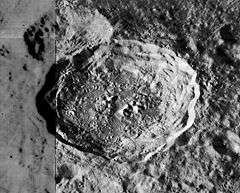Sharonov (lunar crater)
Sharonov is a lunar impact crater that lies on the Moon's far side. It is located to the southeast of the crater Anderson, and to the southwest of the ray-covered Virtanen. To the south-southeast of Sharonov lies Valier.
 Lunar Orbiter 2 image (mosaic of high and low resolution images) | |
| Coordinates | 12.4°N 173.3°E |
|---|---|
| Diameter | 74 km |
| Depth | Unknown |
| Colongitude | 188° at sunrise |
| Eponym | Vsevolod Vasilievich Sharonov |

This crater is roughly circular, with a slight outward bulge along the southern rim. The rim edge is well-defined and has not been significantly degraded as a result of impact erosion. Sharonov partially overlays the smaller crater Sharonov X along the northwestern rim, which in turn connects to the southeastern outer rim of Anderson. The inner walls of Sharonov display some terraces, especially along the northern half. The interior is not marked by any significant impacts, but there are some ridges near the midpoint.
Sharonov is probably part of the Eratosthenian System, but may be part of the Upper Imbrian System.[1]
The crater lies within the Freundlich-Sharonov Basin.
Satellite craters
By convention these features are identified on lunar maps by placing the letter on the side of the crater midpoint that is closest to Sharonov.
| Sharonov | Latitude | Longitude | Diameter |
|---|---|---|---|
| D | 13.5° N | 175.4° E | 17 km |
| F | 12.3° N | 176.2° E | 14 km |
| X | 14.1° N | 172.7° E | 36 km |
References
- Stratigraphy of Lunar Craters, Don E. Wilhelms and Charles J. Byrne, January 23, 2009, Table 5.2
- Andersson, L. E.; Whitaker, E. A. (1982). NASA Catalogue of Lunar Nomenclature. NASA RP-1097.CS1 maint: ref=harv (link)
- Blue, Jennifer (July 25, 2007). "Gazetteer of Planetary Nomenclature". USGS. Retrieved 2007-08-05.CS1 maint: ref=harv (link)
- Bussey, B.; Spudis, P. (2004). The Clementine Atlas of the Moon. New York: Cambridge University Press. ISBN 978-0-521-81528-4.CS1 maint: ref=harv (link)
- Cocks, Elijah E.; Cocks, Josiah C. (1995). Who's Who on the Moon: A Biographical Dictionary of Lunar Nomenclature. Tudor Publishers. ISBN 978-0-936389-27-1.CS1 maint: ref=harv (link)
- McDowell, Jonathan (July 15, 2007). "Lunar Nomenclature". Jonathan's Space Report. Retrieved 2007-10-24.CS1 maint: ref=harv (link)
- Menzel, D. H.; Minnaert, M.; Levin, B.; Dollfus, A.; Bell, B. (1971). "Report on Lunar Nomenclature by the Working Group of Commission 17 of the IAU". Space Science Reviews. 12 (2): 136–186. Bibcode:1971SSRv...12..136M. doi:10.1007/BF00171763.CS1 maint: ref=harv (link)
- Moore, Patrick (2001). On the Moon. Sterling Publishing Co. ISBN 978-0-304-35469-6.CS1 maint: ref=harv (link)
- Price, Fred W. (1988). The Moon Observer's Handbook. Cambridge University Press. ISBN 978-0-521-33500-3.CS1 maint: ref=harv (link)
- Rükl, Antonín (1990). Atlas of the Moon. Kalmbach Books. ISBN 978-0-913135-17-4.CS1 maint: ref=harv (link)
- Webb, Rev. T. W. (1962). Celestial Objects for Common Telescopes (6th revised ed.). Dover. ISBN 978-0-486-20917-3.CS1 maint: ref=harv (link)
- Whitaker, Ewen A. (1999). Mapping and Naming the Moon. Cambridge University Press. ISBN 978-0-521-62248-6.CS1 maint: ref=harv (link)
- Wlasuk, Peter T. (2000). Observing the Moon. Springer. ISBN 978-1-85233-193-1.CS1 maint: ref=harv (link)